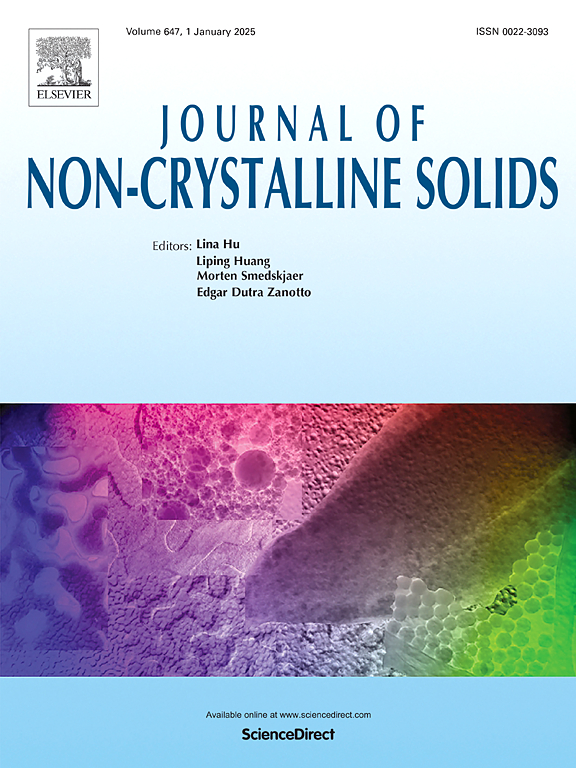Full-spectrum solid-state lighting with temperature self-monitoring using Ag clusters and Eu³⁺ co-doped borate glass
IF 3.5
3区 材料科学
Q1 MATERIALS SCIENCE, CERAMICS
引用次数: 0
Abstract
Ag clusters and Eu3+ co-doped borate glasses were synthesized via high-temperature melting and quenching. Fluorescence spectroscopy and fluorescence decay curves indicated energy transfer from Ag clusters to Eu3+, and the Dexter model confirmed that the energy transfer mechanism is dominated by dipole-dipole (D-D) interactions. By adjusting Eu3+ concentration, warm white light emission was achieved in the Ag cluster/Eu3+ co-doped borate glasses. The emission spectra of W-LED devices, composed of Ag cluster/Eu3+ co-doped borate glasses and a 310 nm LED chip, were tested, with color coordinates, color temperature, and color rendering index (CRI) of (0.38, 0.37), 3808 K, and 90.4, respectively. Further spectral tests under varying driving currents and temperatures demonstrated that the Ag cluster/Eu3+ co-doped borate glasses are stable candidates for W-LED materials. Additionally, the optical temperature sensing properties of the Ag cluster/Eu3+ co-doped borate glasses enabled the W-LED device to achieve self-temperature monitoring.
采用Ag团簇和Eu³+共掺杂硼酸盐玻璃制备的温度自监测全光谱固态照明
采用高温熔炼和淬火法制备了Ag团簇和Eu3+共掺硼酸盐玻璃。荧光光谱和荧光衰减曲线显示Ag簇向Eu3+的能量转移,Dexter模型证实能量转移机制以偶极子-偶极子(D-D)相互作用为主。通过调整Eu3+的浓度,Ag团簇/Eu3+共掺硼酸盐玻璃实现了暖白光发射。测试了由Ag簇/Eu3+共掺杂硼酸盐玻璃和310nm LED芯片组成的W-LED器件的发射光谱,色坐标为(0.38,0.37),色温为3808 K,显色指数为90.4。在不同驱动电流和温度下的进一步光谱测试表明,Ag簇/Eu3+共掺杂硼酸盐玻璃是W-LED材料的稳定候选材料。此外,Ag簇/Eu3+共掺杂硼酸盐玻璃的光学温度传感特性使W-LED器件能够实现自温度监测。
本文章由计算机程序翻译,如有差异,请以英文原文为准。
求助全文
约1分钟内获得全文
求助全文
来源期刊

Journal of Non-crystalline Solids
工程技术-材料科学:硅酸盐
CiteScore
6.50
自引率
11.40%
发文量
576
审稿时长
35 days
期刊介绍:
The Journal of Non-Crystalline Solids publishes review articles, research papers, and Letters to the Editor on amorphous and glassy materials, including inorganic, organic, polymeric, hybrid and metallic systems. Papers on partially glassy materials, such as glass-ceramics and glass-matrix composites, and papers involving the liquid state are also included in so far as the properties of the liquid are relevant for the formation of the solid.
In all cases the papers must demonstrate both novelty and importance to the field, by way of significant advances in understanding or application of non-crystalline solids; in the case of Letters, a compelling case must also be made for expedited handling.
 求助内容:
求助内容: 应助结果提醒方式:
应助结果提醒方式:


